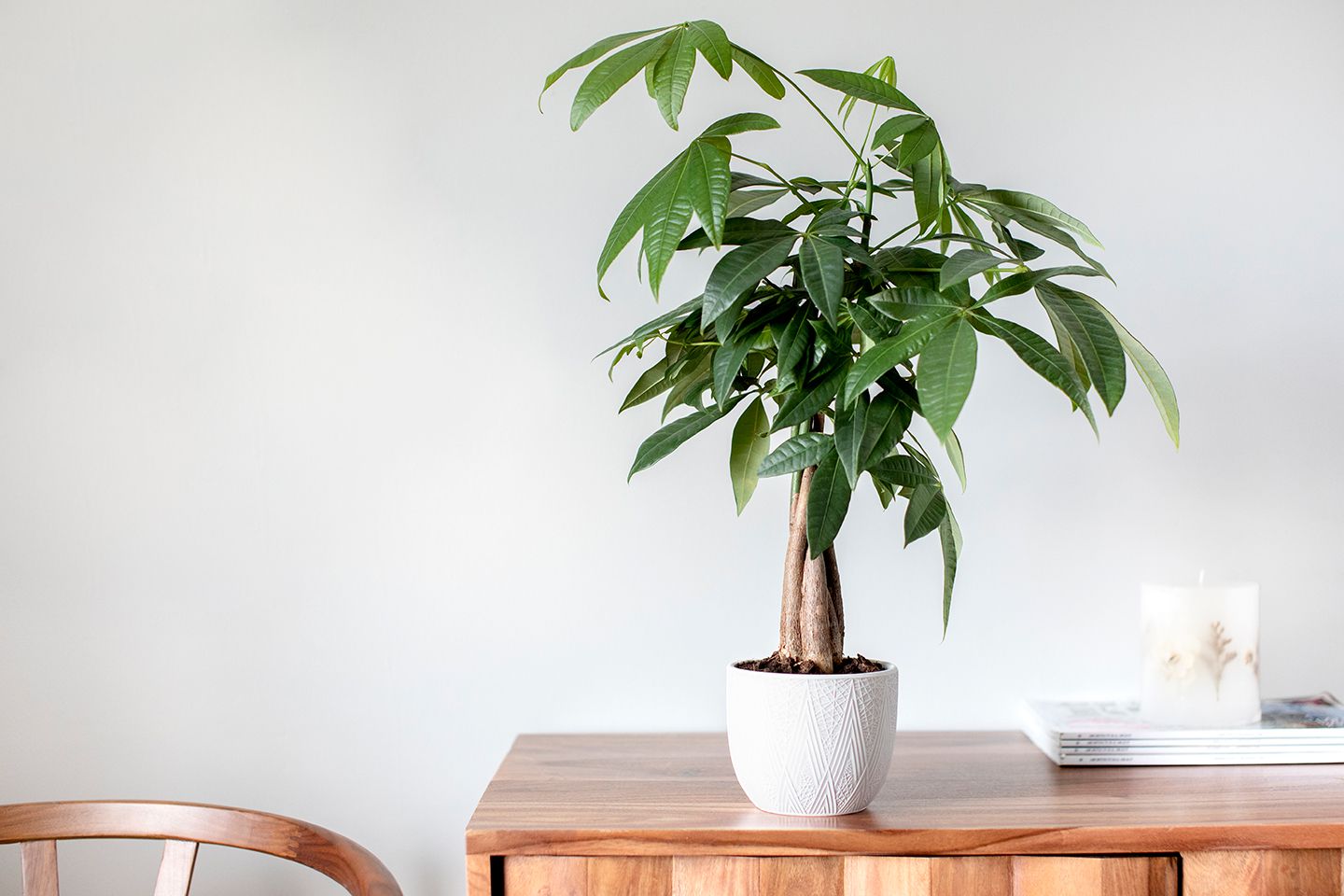
Money Tree is one of the favorite house plants across the globe. It's also a powerful symbol of good fortune, wealth, and positive energy.
In this brief guide, we’ll reveal all the secrets of Money Tree care. We'll show you seven Money Tree care tips and how to braid this plant. That's not all. We will also discuss some of the common problems you may encounter and provide practical solutions to counter them.
But before we get into the details, let's look at some basics about Money Tree.
|
Botanical Name |
Pachira Aquatica |
|
Common Name |
Money Tree, Guiana Chestnut, Malabar Chestnut. |
|
Family |
|
|
Plant Type |
Tropical wetland tree, grown as a houseplant. |
|
Mature Size |
Indoors: 6-8 feet tall; Outdoors: up to 60 feet tall. |
|
Sun Exposure |
Bright, indirect light |
|
Soil Type |
Well-draining, slightly acidic. |
|
Soil pH |
6.0 - 6.5 |
|
Bloom Time |
Rarely blooms indoors |
|
Flower Color |
White, pale yellow, with long, thread-like stamens. |
|
Hardiness Zones |
10-12, USDA |
|
Native Area |
Central and South America (swamps and wetlands.) |
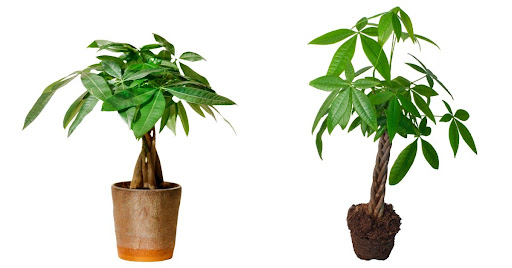
Part 1: Historical Significance of Money Tree
Money Tree or Pachira aquatica has a canopy of glossy leaves and a sturdy trunk. According to Feng Shui, this tree harmonizes the five essential elements: Earth, Water, Fire, Wood, and Metal.
Today, the Money Tree has become a cherished symbol of home prosperity and harmony. But how did this unassuming plant become popular as “Money Tree?”
Legend has it that a Taiwanese farmer was just about to go broke. In one fateful moment, he chanced upon an odd Pachira aquatica. He started growing and selling it, changing his life around overnight. The farmer's wealth rose, and the plant became "Money Tree.”
Do you also want to add this fantastic plant to your house? Get it right now from Greenscape! If you already have this tree, here are the essential care tips you must follow.
Part 2: Basic Money Tree Care Tips For Everyone
The beauty of the Money Tree lies not only in its stunning looks but also in its effortless care routine. Even a novice plant parent can keep it healthy with a simple exercise. Check out other easy-care plants at Greenscape.
Now, here are seven indispensable Money Tree Care Tips for you.
Tip 1. Maintain Proper Light
Light is your Money Tree's lifeblood. However, too much direct sun can burn it. On the other hand, too little light can stop the growth. The ideal scenario is a brilliant, indirect light that lets its leaves bask without taking on the sun's blazing glare.
Ideal Location for Your Tree
- Place near North or East-Facing Windows.
- Place a few feet away from the direct rays.
- Use sheer curtains to soften harsh sunlight.
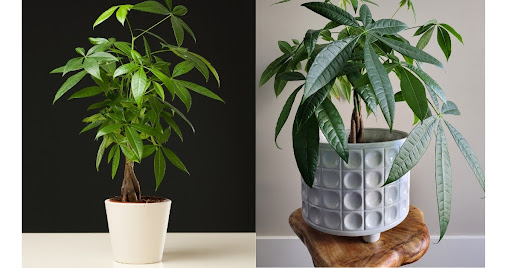
Tip 2. Make a Watering Schedule
Your Money Tree stores water reserves in its trunk. It can be forgiving of the occasional lapse in watering. However, it's not one to tolerate excess. So, use the dry-out technique to water Money Tree.
The "Dry Out" Technique
- Stick your finger down an inch into the soil. Is it dry or damp? You can also use a moisture meter for it.
- If the soil is dry, water until it drips from the bottom.
- Never leave it to sit in puddled water.
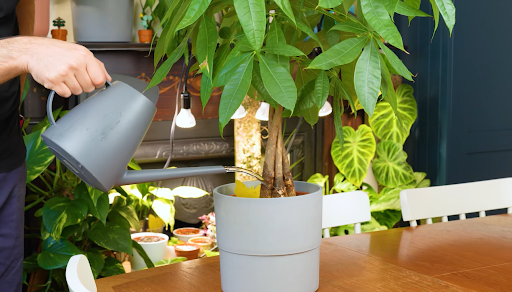
Overwatering Signs:
- Yellowing leaves, particularly at the base.
- Stems turning mushy.
- A foul, musty smell coming from the soil.
Underwatering Sign:
- Leaves droop dramatically.
- Crispy, brittle edges on the foliage.
- Growth of the plant stops.
Tip 3. Use Ideal Soil
Your Money Tree's roots grow in a soil that is welcoming and practical. It should be a well-draining, slightly acidic soil mix that does not allow water to linger. So,
- Select a potting mix that has the peat-moss balance.
- Avoid heavy clay-based soils.
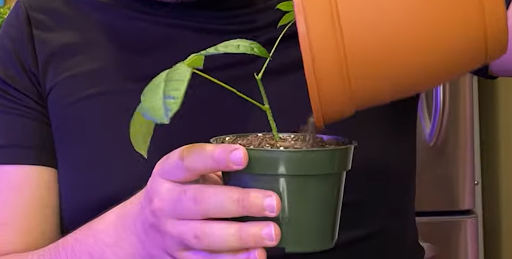
Upgrade Your Ordinary Soil
If standard potting soil is all you’ve got, upgrade it by adding:
- Perlite: Lightweight white granules that aerate the soil.
- Coarse Sand: Just a sprinkle will suffice.
- Coco Coir: This fibrous material provides a perfect mix of aeration and moisture retention.
Tip 4. Maintain Temperature & Humidity
The Money Tree is an indigenous plant of tropical areas where warmth and humidity are abundant. But, as much as possible, avoid extreme conditions for this plant. 65-80°F (18-27°C) is the ideal temperature. Avoid drafts, air conditioners, or heaters, as they create unpredictable conditions.
Humidity Tricks
- A gentle spray of water over the leaves mimics the dewy mornings of its natural habitat.
- Fill a tray with pebbles and water, then set your pot on top.
- Group plants together. They'll create a humid microclimate by sharing their moisture.
- For dry climates, invest in a humidifier to keep conditions tropical.
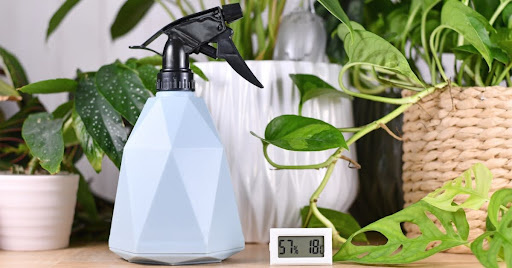
Tip 5. Give Fertilizer in the Growing Season
The Money Tree is a factory of new leaves and stems during the growing season. A steady stream of nutrients will continually be required in spring and summer to fuel this production. Proper fertilization makes for good growth and fantastic foliage.
- Choose liquid fertilizer with NPK equal parts. Use one-third of each of them.
- Dilute fertilizer to half the prescribed dose to avoid overexposure to roots.
- In spring and summer, apply this solution every month.
- Give your plant a break from feeding in fall & winter.
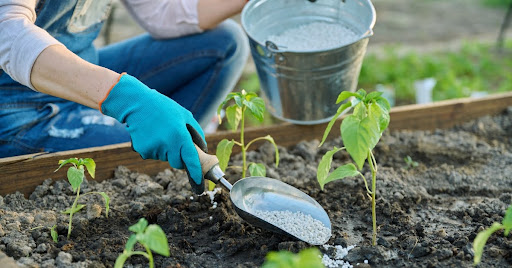
Tip 6. Repot the Plant When Root Bound
Your Money Tree may look happy in its pot. However, the plant becomes "root-bound" over time. It's a condition where roots tightly circle the pot. It leaves little room for growth and makes it difficult to absorb nutrients. So repot the plant to a bigger pot.
When Should You Repot?
The General Rule: Every 2-3 years.
Warning Signs:
- Roots grow out of holes in the drainage.
- Roots curling within the inside of the pot.
- Soil is drier than usual, just a day or two after being watered.
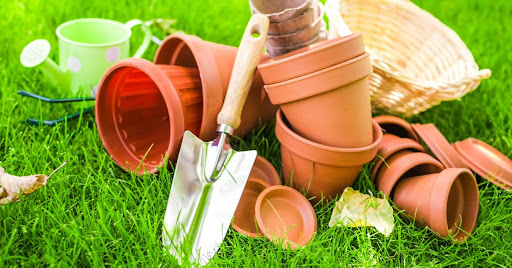
Brief Repotting Guide
- Choose a pot with holes that are only 1-2 inches wider in diameter than the current one.
- Carefully pull your Money Tree from its old pot without injuring its roots.
- Loosen any surrounding roots.
- First, add a layer of new potting mix to the new pot.
- Plant into the new home with the top of the root ball level and the pot's rim.
- Add more potting mix around the root ball, and water thoroughly.
Tip 7. Regular Pruning of Your Money Tree
Pruning might feel like a betrayal. Why snip at a plant you’re trying to grow?
Yet, it’s one of the most vital steps in maintaining a bushy and shapely Money Tree.
Why Prune?
- Keep your Money Tree from getting too wild.
- Pruning encourages fuller, denser growth.
- Take out dead or damaged branches.
Pruning Guide
- Use sharp, sterilized pruning shears or scissors.
- Remove yellow or brown leaves first.
- Prune overgrown branches just above a leaf node.
- Shape your Money Tree for symmetry and balance.
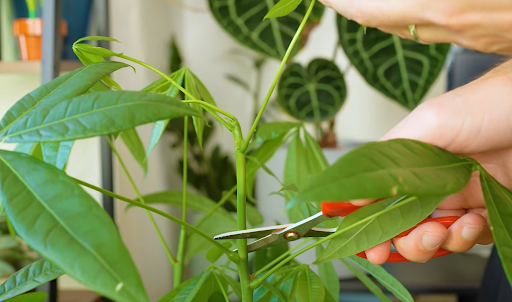
Now that you’ve seen how to care for a Money Tree let's give you a bonus tip. We are about to show you a technique that's quite popular with Money Tree.
Part 3. Bonus Tip - Braiding the Trunk of Money Tree For Aesthetics.
Braiding is a technique that elevates your plant's aesthetics while carrying a deep symbolic resonance. In this technique, the plant's stems are braided when young. After their growth, the wooden stem looks just like beautifully woven hair.
This technique also has a symbolic meaning. In Feng Shui, the intertwined trunks embody the interconnectedness of the five elements, inviting harmony and prosperity into your space.
While many Money Trees come pre-braided, creating this masterpiece can be satisfying.
How to Braid a Money Tree Trunk
Step 1: Select a young money tree. Look for green, supple stems, and about a foot tall. You can also use three different young plants.
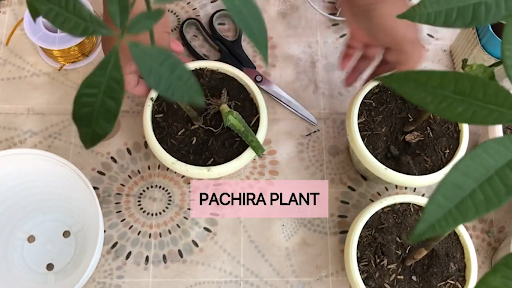
Step 2: Pick three sturdy stems of similar thickness. These will serve as the “strands” of your braid. Choose the latest stem as the center.
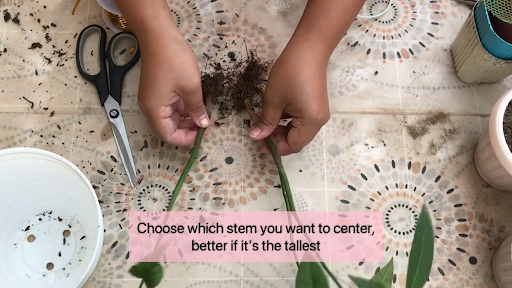
Note:
You can remove the stems from the soil gently for your ease.
Step 3: Collect the stems and bring them together gently. Loosely weave one stem over the other in a repeating pattern.
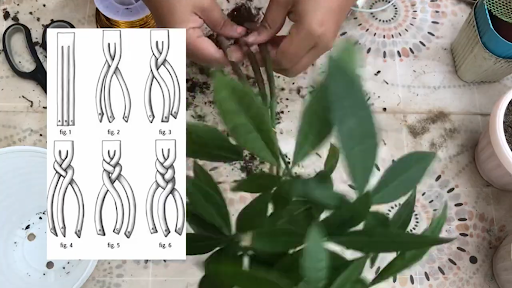
Step 4: Use plant-friendly twine to hold the braid in place once you’ve braided as far as the stems allow.
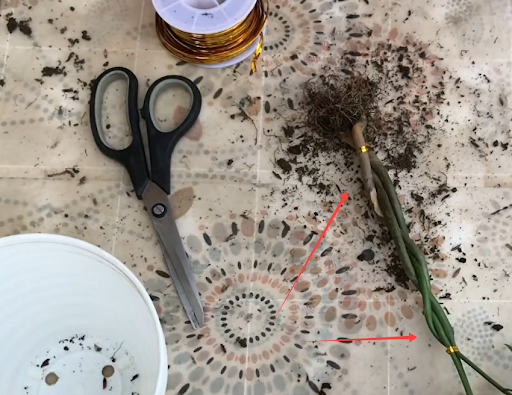
Note:
Ensure the tie is slightly tight but not constricting!
Step 5: As your Money Tree matures, the stems will elongate. Gradually include this new growth into the braid.
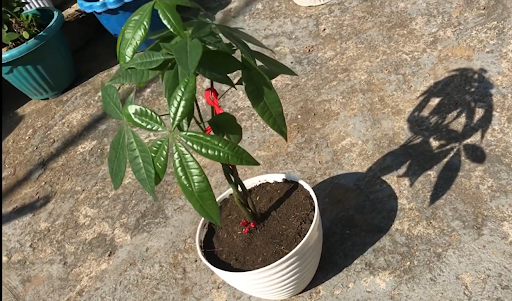
Over time, the stems will naturally fuse into a cohesive, braided trunk.
For an in-depth look, check out this video tutorial on perfecting the art of trunk braiding.
After all this Money Tree How To Care, let's move on to some common problems people encounter.
Part 4. Common Problems in Money Tree Care
Even the most devoted people can't altogether avoid hiccups regarding Money Tree care. However, most problems can be solved with a watchful eye, swift action, and a slight change in your care routine. Let's check these common problems and their solutions.
-
Overwatering
Dangers of Overwatering: Root rot, fungal infections, pest infestations.
How to Save an Overwatered Plant:
- Water supply must be immediately ceased.
- Let the soil fully dry out.
- Plant in new, fresh, draining soil.
- Trim away any mushy, rotting roots with sanitized tools
-
Pests
Common Pests: Spider Mites, Scales, Mealybugs.
Solutions & Preventive Measures:
- Inspect regularly to find them early!
- Quarantine infected plants as a precaution to prevent dissemination.
- Damply wipe leaves or rinse very gently with a soft stream.
- Apply neem oil or herbal pesticide for persistent infestations.
-
Leaf Issues
Common Issues: Yellowing, browning, or dropping leaves.
Possible Causes: overwatering, underwatering, pest infestation, nutrient deficiencies.
Solutions & Preventive Measures:
- Give your plant bright, indirect light.
- Water according to the soil's moisture levels.
- Keep conditions stable and away from drafts or extremes.
- Mist the leaves to boost moisture.
- Check for and treat infestations regularly.
- Feed your Money Tree during its growth phase with a balanced fertilizer.
Conclusion
Money Tree care is much more than a routine. It's an act that rewards you with lush greenery in your home. Even though the steps seem simple, the results can be dramatic.
We’ve discussed seven Money Tree care tips along with the braiding method and common issues. We hope this brief guide comes in handy while you are taking care of your Money Tree.
Moreover, if you want this excellent plant for your home, Greenscape provides you with an ideally grown Money Tree right here.
FAQs About Money Tree Care
Q1. How can I tell if my Money Tree is Growing Well?
A flourishing Money Tree has leaves that are lush and green. New sprouting consistently is also a sign of growth. The trunk stands strong and resilient. If it holds its shape without sagging, wilting, or drooping, you’ve got a healthy plant on your hands!
Q2. Can I use rainwater to water my Money Tree?
Absolutely! Rainwater is nature's gift to your Money Tree. Unlike tap water, it's pure and chemical-free, which can sometimes carry harsh additives. Just be sure to gather it in a clean container to keep out any contaminants.
Q3. What's the best method for Money Tree Propagation?
Regarding Money Tree propagation, stem cuttings are your best ticket. Choose a healthy stem with at least two leaf sets. Let the cut end dry briefly, then place it in either water or moist soil. Watch closely as tiny roots emerge. After that, transfer it into a big container with nutrient-rich soil.



